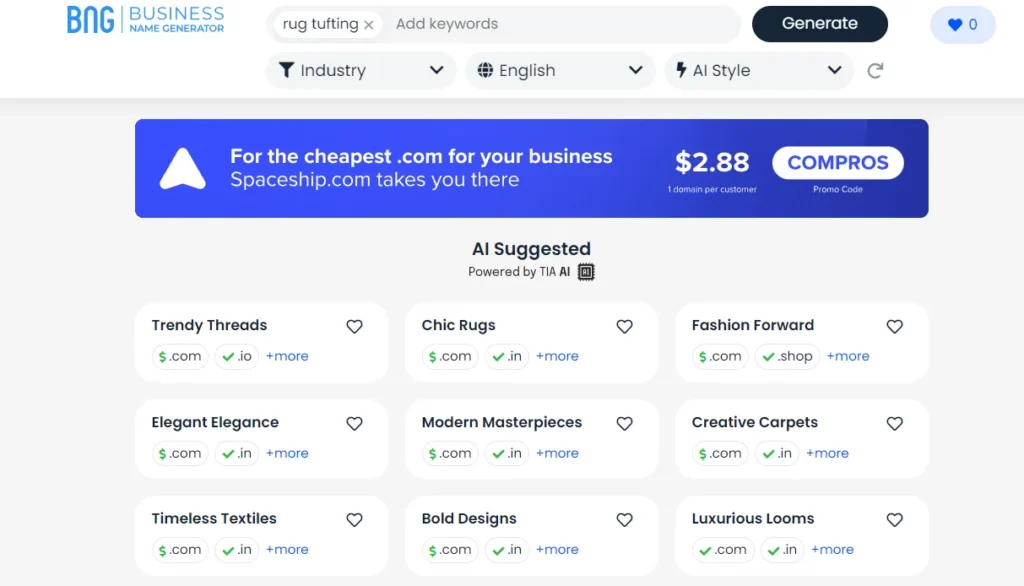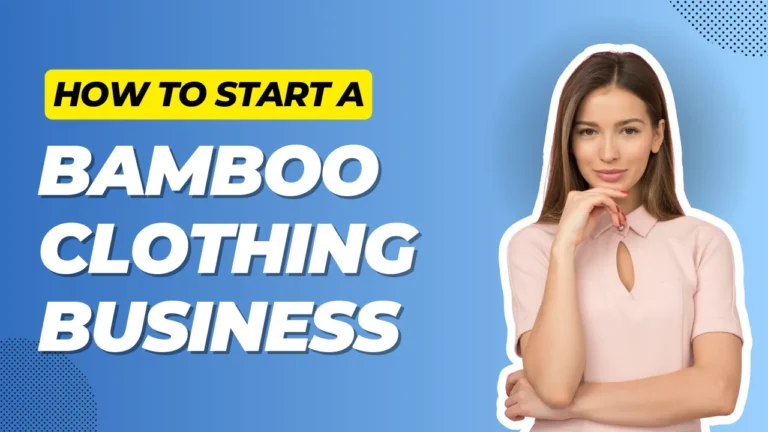Do you want to know how to start a rug tufting business? You’ve chosen the right place.
If you have a passion for creativity, craft design, art, and a spirit for entrepreneurship, then choosing this business idea can be your right decision.
Starting a business from scratch is not easy; even if you are an expert in tufting skills, some essential steps must be followed.
So, our step-by-step guide is helpful whether you are an aspiring rug designer or a rug tufting professional.
The carpets and rugs market is continuously growing.
As you can see in the infographics, the global rugs market was valued at US $50 billion in 2022 and is expected to reach US $106 billion by the end of 2030.

- Global carpets and rugs market valued at $50.29 billion in 2022
- Projected growth to US $55.28 billion in 2023
- Expected to reach US $106.01 billion by 2030
You will discover in this post:
- A basic introduction to rug tufting
- Rug tufting business opportunity
- Business planning and research
- The process of setting up the business
- Marketing and branding strategy
By reading the blog post, you can learn the steps, insights, and a clear path for starting a business. So grab a coffee, sit back, and dive into the process.
Are you ready? Let’s get started.
What is rug tufting?
Rug tufting is a technique used for creating beautiful, textured rugs using hand-threading loops of yarn or a particular rug tufting machine.
The process is simple: pulling loops of yarn or fabric through a woven base to create a soft and plush surface, with its versatility and ability to create intricate designs.
According to the market trend and demand, rug tufting has become a popular choice for everyone for adding warmth and style to any space.
Is rug tufting profitable?
Yes, starting a rug tufting business can be profitable.
The concept is simple: create and sell rug tufting kits and finished rugs. Also, you can provide custom rug tufting service on customer demand.
Why the business can be a good selection?
- Low startup costs
- High-profit margins
- Low competition
- Growing demand for handmade rugs
- Potential for scalability
- Sustainability in market demand
- You can create unique and custom designs
If you have good crafting and tufting skills, then the line is most lucrative; focus only on your target market to provide the best products.
It is a simple business model, but you need to learn proper skills and have passion, dedication, interest, and critical thinking ability; those are essential to work continuously.
Be it any business industry, it takes time to achieve success; you must understand the industry, target customers, competitors, and business process very well.
However, the factors that matter in the profitability of a business include market demand, competition, product quality, and marketing strategy.
Profitability depends on:
- Target market: DIY crafts interested people, home decor, individual clients, etc.
- Pricing strategy: Rug tufting is an art and most customers are attracted to buy those craft items, but your pricing matters (depending on quality).
- Your marketing strategy: Online marketing- social media, online advertising, offline marketing, word-of-mouth, and public relations.
According to a survey of rug tufter, the profit margin for rugs is around 30%, and some tufter exist in the market who are making around 50% profit margin (because of their skills and unique designs).
You can search online to learn more about the profit margin and market trends.
How to start a rug tufting business? process

1. Conduct proper research on the market
We always guide our readers to conduct market research before launching a business. This is crucial for understanding the market demand, need, customer preferences, and competitive landscape of the target market.
So, when you plan to start your business, conduct proper research on the market, gain valuable insights into consumer trends, learn unique designs, and analyze what types of fabric and designs are more popular in the market.
Fabric: Wool, cotton, synthetic fiber, silk, etc.
A popular type of rug pattern:
- Geometric rugs: Bold, geometric patterns.
- Abstract rugs: Abstract patterns with a variety of colors and textures.
- Floral rugs: Floral patterns inspired by nature.
- Animal print rugs: Animal prints, such as leopard, zebra, or giraffe.
- Tribal rugs: Tribal patterns inspired by traditional African or Native American designs.
Also, market research can reveal untapped opportunities and potential challenges within the rug tufting industry. With this information, you can make better and more informed decisions, which is important for success.
Opportunities and ideas:
- Create custom rugs
- Rug tufting workshops and classes
- Start a tufting supplies store
- Sell rug tufting kits online.
- Provide ruf tufting services.
Potential challenges:
- Competition
- Marketing and advertising
- Overhead costs
- Time and efforts
Analyze the market growth or size, market competition, your target audience, pricing strategy, marketing, sale strategy, and startup costs.
These are some popular rug styles you can consider when starting the making process.
Also, your research is vital to assess the current market demand and trends.
- Traditional
- Contemporary
- Moroccan
- Shag
- Area rug
- Runner rug
- Outdoor rug
- Flatweave rug
- Hand-knotted rug
Identify ideal customers:
Identify target customers by understanding individuals’ demographics, psychographics, and behavioral characteristics.
Find are interested in purchasing tufted rugs, and who can be your potential customer.
Here are some ideas:
- Homeowners
- Interior designers
- Hotels and restaurants
- Office buildings
- Retail stores
- Online shoppers
2. Write a rug tufting business plan

As a small business owner, you may decide your target market, goals, and objectives for starting the rug tufting business.
The step – of writing a business plan is defining your business purpose, roadmap, strategy, and planning.
As a beginner or new entrants to any business field, we understand that you may also feel uncertain about taking the initial step.
Here are some steps for writing a business plan, follow:
- Executive summary: Highlight the key points of the business goal and overview.
- Goals: Clearly define your objectives for the rug tufting business, such as achieving a specific sales target or expanding your product line.
- Market research: Analyze the current market, trends, demand, your target audience, competitors, and other essential market fluctuations.
- Target customer: Identify your ideal customers, focusing on their demographics, interests, and rug preferences.
- Unique selling proposition: Your business should have a USP and clear differentiation from the market service, unique features/designs/quality, and more customer value.
- Production and sourcing: Rug tufting process, equipment, raw material sourcing, supplier connection, supply chain, quality control, scalability.
- Marketing: Outline your strategy to reach clients through – social media, paid advertising, content marketing, offline promotion, word-of-mouth marketing, etc.
- Financial projections: Estimate your initial start-up cost, expenses for buying supplies, profits projection, funding sources, etc.
- Team: Plan for hiring individuals with expertise, skills, and experience in the crafting field.
For aspiring rug tufter, here are some tips for success – write a proper plan, research, and put your dedication and hard work into making the line more lucrative.
No matter your skills, experience, and knowledge, take the first step toward the crafting business. Create your roadmap to work accordingly.
Don’t rely on others to pave the way for you.
Never dwell on the possibility of failure. Instead, focus on achieving success.
Focus on self-improvement, learning new skills, and think new or unique designs to differentiate yourself from the market competition.
3. Choose a rug tufting business name

Next, brainstorm a name for your rug tufting business; a business name helps establish brand identity in the market.
When you brainstorm, focus on a related business name, think of terms like (rug, tufting, handmade, artistic, and crafted), and use this type of word in a name.
Analyze the other businesses, check online websites, and create a unique, attractive name. Consider a business name generator, to save time and effort in finding a name.
Some tips for finding a good name:
- Focus on the target audience
- Keep the name simple and easy to remember
- The name should be easy to say or spell
- Be unique to stand out from the crowd
- Use keywords in your business name
- Check for availability (domain or social media handles)
Here are some business name ideas:
- TuftedTapestries
- RugRevolution
- TuftedTreasures
- ArtisanTufts
- TuftedVisions
- KnotCrafters
- TuftedElegance
- TuftedTales
- LuxeLoops
- TuftedTrove
Register a domain:
Once you have selected a name, the next step should be registering a domain for online presence.
A domain name is the business address on the internet; your customer can browse or visit your website with this address.
Find a reputed domain registrar (Namecheap, Goaddady, Bluehost) who offers a variety of domain name extensions (.com, .net, .org, .in).

Your extension should be country-relevant, so consider your country code top-level domain name, for example, USA (.com), India (.in), etc.
4. Learn the basics of rug tufting
Begin your venture with a solid foundation, learn the art of rug tufting, its process, and techniques, and acquire the essential knowledge to help you become professional.
Understand different types of tufting methods. Master the use of digital tools, equipment, and machines. Learn the fabric characteristics to create more quality tufted rugs.
Skills needed to start the business:
- Basic tufting techniques
- Designing skills with creativity
- Business and marketing skills
- Basic digital marketing knowledge
- Develop your basic communication skills
- Learn the social media and content marketing
Develop your basic tufting skills:
- Learn the tufting techniques: Cut pile, loop pile, carving
- Practice basic tufting patterns: Straight lines, Curves, Shapes
- Practice regularly to improve your tufting skills and experience
- Learn from experienced tufters; you can also reach out to them online
- Find online or offline workshops to learn the basic techniques and tips
- Create your designs: Sketch designs yourself following online resources.
- Make mistakes, learn from mistakes, and enjoy the process.
Experiment with different yarn types:
| Yarn type | Pros | Cons |
|---|---|---|
| Acrylic yarn | Durable, affordable, easy to care for | Not as soft as natural fibers |
| Cotton yarn | Soft, absorbent, breathable | Not as durable as synthetic fibers |
| Wool yarn | Warm, durable, resilient | Can be itchy |
| Blend yarn | Best of both worlds | Expensive than single-fiber yarn |
| Shag yarn | Creates a luxurious feel | Difficult to work with |
How do you learn the rug tufting process?
- Start with the basics.
- Learn from online tutorials (YouTube videos, read blog posts, explore social media).
- Rug tufting workshops (Join online and offline workshops with self-practice).
- Read books and magazines.
- Experiment with different techniques
- Join the rug-tufting community.
5. Develop your unique designs
The rug tufting and carpet market is already highly competitive, but there is also a gap for new entrepreneurs.
You need to develop your unique designs with high-quality materials, use your creative mind to attract the audience’s attention and create realistic art to succeed in this competitive market.
Rug tufting is an art; although you need to follow the market trend and customer demand, you need to create new designs to attract new customers.
Here are a few tips you can consider:
- Be creative and original
- Follow the market trends
- Create designs according to the target market
- Share your creativity on Social Media
- Get feedback from others
- Start brainstorming new patterns, colors, and textures
- Don’t be afraid to make mistakes
6. What do you need to start rug tufting?
To create quality products, you must understand the raw materials, equipment, and machinery required for the tufting project.
The best quality supplies can help you to maximize your creativity and work experience.
Types of rug tufting:
Using rug tufting, you can create different types of designs and art. The most common rugs are cut pile rugs, loop pile rugs, and shag rugs.
Understand the rug tufting types before buying equipment.

Manual Rug Tufting
For small projects – if you want to create designs for personal use, consider the manual rug tufting method.
This is the traditional method of rug tufting, and it is suitable for those who want to create something creative for their interest.
Manual rug tufting is a time-consuming process, but the equipment is inexpensive.
Machine Rug Tufting
However, starting a commercial project requires efficiency, productivity, and quality.
Tufting a rug using the machine can be the best and ideal option; we hope you understand.
It uses a computer-controlled automatic machine.
This machine is mainly for business and commercial purposes.
You can create designs faster with less time, but the machine is more expensive.
Professional rug tufting requires proper supplies and tools. We have listed some essential equipment and raw materials:
2 in 1 Cut & Loop Pile Tufting Gun
- Rug Tufting Gun with Carpet Trimmer Kit
- 2 in 1 Cut & Loop Pile Carpet Gun and Carpet Carving Clippers,
- Rug Maker Machine Starter Kit for Beginners
Buy raw materials and equipment:
Equipment:
- Tufting gun
- Tufting frame
- Yarn
- Fabric
- Latex glue
- Scissors
- Razor blade
Essential supplies:
- Tufting tweezers
- Tufting needles
- Tufting board
- Tape
- Carpet pad
- Sewing machine
Tufting Fabric
Tufting Fabric
Tufting Fabric
Additional supplies:
- Design templates
- Tufting marker
- Tufting roller
Purchase a rug-making machine
Invest in a reliable rug-making machine that is most useful for your business.
When choosing the right machine, consider your needs, budget, and work efficiency.
Many types of machinery are available in the market along with their features and functionalities, so consider the best one suitable according to your needs.
7. Set up a tufting workspace
Create a well-equipped workspace for maximum productivity and smooth work experience. Most importantly, that helps to improve your work efficiency in rug tufting projects.
Set up your workspace with proper equipment and supplies, organize your materials and tools, optimize the room with lights, and create a natural, environment-friendly workspace.
When you decide on the location or workspace:
- Check the space should be large and enough for tufting
- Create a clear workspace with proper lighting
- A good environment is important for minimal noise
- Also, check the electricity and ventilation
- Prepare for safety in this workplace
- Good internet, storage, and cleanliness should be the most
- Also, you can design the area to create a comfortable space
After deciding on the workspace for your project, next;
- Choose an appropriate space,
- Assemble and mount your tufting frame,
- Organize all equipment, tools, and materials,
- Protect your workspace from yarn fuzz and debris,
8. Legal paperwork and licensing

Running a business requires proper legal consideration and some basic requirements according to local and state regulations; make sure to obtain and fulfill the legal paperwork.
Paperwork:
- Business License
- Sales tax permit
- Apply for an EIN
- Zoning permit
- Fire inspection
- Health Inspection
Accounts:
- Business checking account
- Business savings account
- Credit card
Business Insurance:
- General liability
- Product liability
- Workers’ compensation
This is only the basic information; if you want to know more deeply what exactly you need, according to your location, and business size, then it is recommended to consult a legal advisor or attorney.
9. Market your rug products

Now that you have honed your skills, developed unique designs, and set up your workspace, it’s time to showcase your rug products to the world.
You must develop and follow the right marketing strategies to get results in the competitive market, from building an online presence through websites to social media marketing.
- Online presence: Website, social media, online marketplaces.
- High-quality visuals: Professional photography and videos.
- Targeted advertising: Google Ads, social media ads.
- Influencer marketing: Collaborate with interior design influencers.
- Collaborations: Partner with interior designers and home decor stores.
- Video Content: Engaging videos of the rug-making process.
FAQs [Frequenlty Asked Questions]
How long does it take to tuft a rug?
The time to tuft a rug varies depending on the size and complexity of the design. Still, it depends on your experience and skills.
Can you make money from rug tufting?
Yes, you can make money from rug tufting.
What do I need to start a tufting business?
You will need a tufting gun, a backing material, rug yarn, and a cutting tool; a perfect workspace is also mandatory.
How to start selling tufted rugs?
You can sell tufted rugs both online or offline by creating a store.
Is there a market for tufted rugs?
Yes, there is a thriving market for tufted rugs, which has grown significantly in recent years.
How to sell tufted rugs online?
Selling tufted rugs online requires proper marketing skills, an online store, and high-quality products. You can sell your creation by choosing the right online marketplaces (Etsy, eBay, Amazon), on social media platforms (Instagram, Facebook), and by creating a dedicated e-commerce website.
Final thought
Rug-tufting business can be an exciting journey, but it requires dedication, passion, hard work, and patience, from starting to making it profitable.
A combination of artistic flair, technical expertise, and entrepreneurial understanding is essential.
Hopefully, the blog post is helpful and provides a comprehensive guide for you, If there are any other doubts, you can comment. Don’t forget to share and comment.
You may also like;









